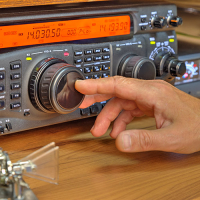Summer skies
 My family and I made a quick run up to Waterrock Knob on the Blue Ridge Parkway around dusk last Sunday (July 19) to get a peek at some celestial luminaries. Venus and Jupiter joined the waxing crescent moon on the western horizon. They danced and played hide and seek amidst layered clouds whose purple backs touched the night while their bellies bathed in the last yellow and orange rays of the sun falling over the western horizon. It was a beautiful, tranquil setting.
My family and I made a quick run up to Waterrock Knob on the Blue Ridge Parkway around dusk last Sunday (July 19) to get a peek at some celestial luminaries. Venus and Jupiter joined the waxing crescent moon on the western horizon. They danced and played hide and seek amidst layered clouds whose purple backs touched the night while their bellies bathed in the last yellow and orange rays of the sun falling over the western horizon. It was a beautiful, tranquil setting.
We found Saturn higher in the southeastern sky, thanks to a “Google Sky” app. I am sure there are numerous “sky apps” out there that work well. If you own a smart phone or a tablet of some type, these are great educational tools. In fact it was Maddie, my 9-year-old, who found Saturn while the rest of us were still mesmerized by the moon, Venus and Jupiter.
Venus and Jupiter will soon be leaving the summer night sky, swallowed by the Sun’s golden glare. But not to worry; they will return in the pre-dawn hours in late August. Meanwhile Saturn will be on display all summer. It is traveling east to west across the night sky. It started out low in the southeastern sky and by mid- to late August will be in the southwest. Saturn can be found between the constellations Libra and Scorpio about 10 degrees northwest of Antares, the brightest star in Scorpio.
As we were getting in the vehicle for the short drive home, a meteor burned across the sky. I don’t know, but it could have been from the Delta Aquarid. The Delta Aquarids is a long-running but often sparse meteor shower beginning around mid-July and continuing into late August. They appear to originate from the constellation Aquarius and are thought to be fragments of Comet 96P/Macholz. The Delta Aquarids don’t produce anything like the night the “Stars fell on Alabama,” but they are something to look for in the night sky. The peak period for the Delta Aquarids will, regrettably coincide with July’s “blue” moon of the 31st. So you may actually see more during these early stages while the night is inky black.
And they’re good practice, as they will be setting the stage for one of the more renowned meteor showers and summertime perennial favorites — the Perseids. Of course it was the Leonids and not the Perseids that fell on Alabama, but the Perseids often put on quite a show with as many as 100 meteors per hour at peak. And, hooray, this year’s peak around August 13 will come in the dark, just a day before a new moon so viewing should be great for a week or better.
Now when you set up for the Perseids, you’ll want your lawn recliner tilted up just slightly facing the northern sky and the constellation Perseus, where the meteors appear to originate. But be sure and pay attention for any wrong-way fireballs because there could easily be a Delta Aquarid or two mixed in the bunch. If the meteor’s tail is pointing towards the south — toward Aquarius — it’s one of those pesky Aquarids.
(Don Hendershot is a writer and naturalist. He can be reached a This email address is being protected from spambots. You need JavaScript enabled to view it..)





